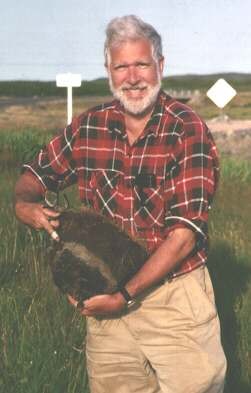Alan Ruffman

Burin Penisula
Southern Newfoundland 1994 *
* Ruffman holding a monolith of modern peat dug out of an area about 100 metres inland from the beach at the head of Taylor's Bay, Newfoundland Canada. His right index finger is pointing at a two centimetre thick bed of clear beach sand laid down on the peat surface in the early evening of November 18, 1929 by the Tsunami created by the "Grand Banks" earthquake and offshore slump on the upper continental slope off the mouth of the Laurentian Channel that separates Newfoundland from Nova Scotia. The tsunami laid sand deposit then is overlaid by 6 to 8 centimetres of peat that has grown since 1929.
M. Sc. Thesis
Crustal Seismic Studies in Hudson Bay, Canada
(PDF - Mb)
An investigation of the first arrival data from the 41 shots of the 1965 Hudson Bay Project is made using a time-term analysis. The most consistent set of shot positions is chosen using water wave information and also with reference to the time-term analysis. A single-layered crust with velocity of 6.33 km/s and an upper mantle velocity of 8.209 km/s are proposed. The Mohorovivic discontinuity is found to have considerable topography with depths ranging from 42.7 km to less that 26 km. The Cape Smith-Wakeham Bay belt and the related Churchill-Superior boundary are extended westward north of the Ottawa Islands. The Churchill-Superior boundary is proposed to extend across Hudson Bay to York Factory. The mantle is indicated to be about 26 km deep beneath Chesterfield Inlet and Baker Lake. The Mohorovivic discontinuity is about 30 km deep to the west of the Ottawa Islands and gradually deepens to about 40 km at Churchill, Manitoba.
Keywords:
Pages:
Supervisors: M. J. Keen / R. Ravindra



